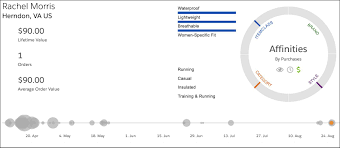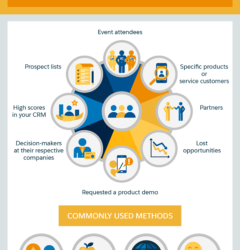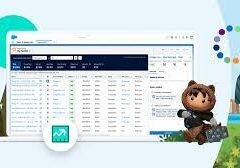Delight your customers with personalized moments at every touchpoint of their journey. Personalize the Customer Journey whether B2B or B2C, whether product or service, whether lead warming or customer loyalty, every journey is better with personalization.
Enhance customer satisfaction by delivering personalized experiences at every touchpoint of the customer journey, whatever the context, with products or services, focusing on lead nurturing or customer loyalty.
Orchestrate sophisticated customer journeys at scale, executing meaningful personalization campaigns across any channel, or all channels.

Personalize the Customer Journey Across Lifecycle
Manage the entire customer lifecycle, from awareness to advocacy, by engaging customers with personalized messages tailored to their buying stage and preferred communication channel.
Achieve real-time customer engagement by adapting messaging and campaigns based on ongoing customer experiences, ensuring every customer feels valued and prioritized.
Utilize AI to transform every customer interaction into a unique and tailored experience, predicting user behavior and automating journey creation based on predictive audience insights.
While we’ll use retail as a case study, these principles are applicable across all industries.
- Cost reduction remains a top priority for IT leaders in 2024, with 41% of respondents highlighting it as their primary focus. In terms of digital agility, only 1% of IT leaders view their company as a digital leader, while 45% describe their processes as convoluted, manual, or reliant on legacy infrastructure.
- Improving personalized customer experiences continues to be a significant goal for retailers in 2024, with email, mobile apps, and web platforms identified as the top three channels for personalization. However, challenges persist in delivering effective personalization, with IT leaders citing budget constraints as the biggest hurdle, followed by concerns over customer privacy and limitations in technology.
- To address these challenges, 74% of IT leaders plan to enhance their tech stack in 2024 to facilitate better personalization. Retailers are increasingly leveraging AI to bolster their personalization efforts, with 65% of respondents already using AI for personalization tasks and another 30% exploring its capabilities.
- There’s a notable opportunity for closer collaboration between tech and marketing teams to deliver personalized cross-channel customer experiences, though currently, only 25% of survey respondents report such collaboration.
- Looking ahead, retailers face tough challenges including price sensitivity, a saturated retail landscape, and the imperative of offering personalized customer experiences. Despite these hurdles, the widespread adoption of AI presents significant potential for enhancing personalization efforts across various touchpoints, from pricing strategies to advertising.
- As we enter 2024, IT leaders are focused on refining their approaches to personalization to ensure better performance and improved customer outcomes. This includes addressing budget constraints, enhancing tech infrastructure, and fostering collaboration between key departments to drive successful personalization initiatives.
Utilizing Salesforce tools empowers you to harness explicit customer data for tailoring content to specific visitor groups, delivering more relevant and personalized experiences.
To effectively prioritize customer segments and initiate personalized efforts with your most valuable visitors, adopt the PVE criteria—Potential, Value, and Ease:
- Potential represents the opportunity to enhance visitor engagement and ROI through personalization.
- Value refers to the total number of contacts within a segment.
- Ease indicates the simplicity of identifying visitors within a particular segment.
Start by focusing on segments with high potential and value, then gradually extend personalization efforts to other segments with promising potential.
Mapping Customer Journeys:
Understand each stage of the customer journey to ensure optimal engagement:
- Form a cross-functional team representing touchpoints with your customers.
- Use exercises like post-it note mapping to detail stages, touchpoints, and key customer activities.
Create a table summarizing each segment’s journey stage, description, engagement touchpoints, and customer actions.
Building Digital Relevancy Maps (DRM):
DRMs serve as a planning framework, aligning content and functionality with major segments across their journey stages.
- Define content to guide engagement and nurture prospects toward business objectives.
- Leverage Salesforce’s rules-based and machine-learning personalization.
Evaluate and Optimize Content:
Assess existing content against DRM-defined journey stages and visitor intentions.
- Use a spreadsheet to evaluate content relevance and identify gaps.
- Focus on producing new targeted content aligned with priority segments.
Data-driven Personalization:
Leverage data—demographics, behavior, and purchase history—to craft personalized journeys.
- Implement CRM systems like Salesforce for comprehensive customer views.
Automate for Efficiency:
Use automation to adjust marketing campaigns in real-time based on customer behavior.
- Dynamically personalize e-commerce content, like product recommendations.
Personalized Email Campaigns:
Craft tailored email content reflecting customer preferences and behaviors.
- Boost conversions and retention with relevant promotions and recommendations.
Social Media Integration:
Tailor social media campaigns based on individual preferences and feedback.
- Create a seamless, personalized experience across channels.
Harness AI for Real-time Insights:
Artificial Intelligence algorithms predict customer behavior and offer personalized recommendations.
- Enhance user experience and drive satisfaction with AI-driven personalization.
Individualized Homepage Experiences:
Enhance your website or mobile app by providing customers with personalized homepage experiences. Tailor product displays and content to align with their preferences, recent purchases, or browsing habits. A dynamically personalized homepage captivates attention and encourages deeper engagement.
Integration for Personalized Customer Journeys
Crafting personalized customer journeys requires a comprehensive strategy that integrates data-driven marketing, automation, and a deep understanding of customer behavior. By breaking down organizational barriers, connecting multiple channels, and utilizing AI-driven algorithms, businesses can enhance customer experiences, foster loyalty, and boost conversion rates.

Stay Ahead with Adaptive Strategies
Anticipate customer expectations by continually refining and adapting personalized strategies based on real-time data and feedback. This ensures your brand remains a trusted partner throughout your customers’ journeys.
Leverage Salesforce’s Digital Experience Platform to Personalize the Customer Journey
Gain insights into your priority segments, their journey stages, intentions, appropriate calls to action, and relevant content. Utilize Salesforce’s digital experience platform to deliver highly personalized and impactful experiences to prospects and customers, with measurable performance and business outcomes.













